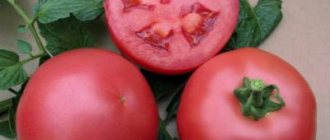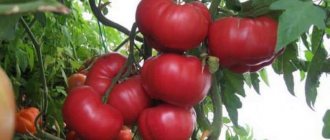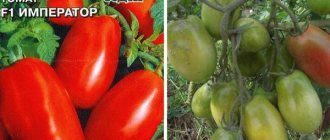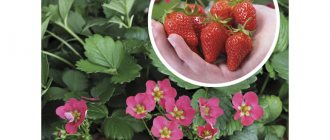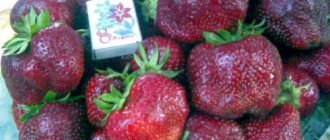Home / Garden / Berries
Back
Published: 07/05/2020
0
Rate this post
This variety is the result of the work of breeders from America. Selva strawberries were obtained by mixing material from the following species: Tufts, Pajero, Brighton. She inherited their best qualities. The variety is distinguished by its remontability, increased productivity, and is adapted for cultivation in different climatic zones. It is popular throughout Europe, but is also grown in Russia.
- 1 Features of the variety and its description
- 2 Landing
- 3 Crop care
- 4 Reviews about the Selva variety
Description of the variety and photo
The Selva variety is an American selection based on three varieties: Brighton, Tufts and Pajero. The bushes are tall, have large leaves and powerful peduncles that can bear large fruits. The flower stalks are noticeably pubescent, rise high above the bush and produce a large number of berries. It also forms a large number of whiskers.
Interesting! Numerous tendrils allow the variety to be grown on trellises.
Due to the large size and heaviness of the berries, up to 1 kg of fruit or even more can be collected from one bush. Remontant variety - bears fruit from May-June until the first frost.
Landing
The basic rules for planting and care are basically the same as for other varieties of strawberries:
- Choose a sunny, wind-protected area, preferably elevated above the ground. Gardeners say: “Strawberries love a hillock.” The berries of plants planted in lowlands do not gain sweetness. This is especially true for Selva, since the berries are initially not very sweet.
- But you can’t plant on a steep slope either! The site should be slightly elevated or have a slope of 2-3°, preferably to the southwest.
- Since Selva is a remontant variety, it is preferable to plant it in the spring - in April-May, and in the southern regions - from the beginning of March. However, in the first year, during spring planting, the harvest will be small.
- If you decide to plant strawberries in the spring, wait until the soil temperature reaches 10°C.
- Autumn planting is carried out from late August to November, depending on the onset of frost in the region.
- As a rule, the more time a plant has to get stronger before frost, the larger the harvest the following year. However, in the southern regions at the end of August and beginning of September it is still too hot for planting. Wait until the heat subsides!
- The most suitable soil type is loamy or sandy loam, neutral or slightly acidic.
- The best predecessors of strawberries on the site: onions, carrots, greens, beets, radishes.
- Solanaceae, cabbage, cucumbers, asters, lilies are not very suitable - possible reserves of nematodes and fusarium pathogens.
Site preparation
In the fall for planting next spring:
- dig up the area with a bayonet;
- remove weeds;
- Apply organic and/or mineral fertilizers at an approximate rate of 8-10 kg per 1 m2 of soil.
In the spring, all that remains is to loosen the top layer of soil and start planting.
If you don’t want to manually remove weeds, you can try 3-4 weeks before sowing, digging up the area and covering it with agrofibre (Spunbond). During this period, the weeds should die in the dark. After this, the agrofibre can be left for the entire growing season and plants can be planted by making cross-shaped cuts in it at a distance of 30 cm from each other and making holes for planting directly through them.
Process
- We make holes approximately 25 cm deep, at a distance of at least 30 cm, and preferably 40-50 cm from each other due to the long mustache. The distance between the ridges is from 40 to 60 cm.
- If the strawberry bed was not fertilized in the fall, we add fertilizer to the holes, for example, the following: 2 cups of ash per bucket of soil, a bucket of compost and a bucket of rotted manure.
- An hour before planting, water the seedlings. We pour soil into the bottom of the prepared holes and form a mound, about 10 cm high. Carefully remove the plant from the pot and distribute the roots so that they evenly go down the mound. Carefully cover with soil and water generously, at the rate of approximately 0.5 liters of water for each seedling.
IMPORTANT! Make sure that the apical bud of the bush (heart) protrudes a LITTLE BIT above the soil surface: if it protrudes too high, it may dry out, and if it is buried, it will rot.
Despite the variety's resistance to diseases and pests, some gardeners recommend rinsing the rosettes in a solution of the following composition before planting: 3 tablespoons of table salt, a teaspoon of copper sulfate per 10 liters of water. Leave the socket in the solution for 10-15 minutes, then rinse well with warm water.
Mulching
Covering the soil between strawberry bushes is very desirable. This will make it possible to water the plants less frequently, avoid weeding and minimize contamination and damage to the berries. For mulching, you can use agrofibre, completely covering the bed with it and making holes for planting, as mentioned above. Or you can use hay or straw, filling the spaces between the bushes with a layer of 15 centimeters immediately after planting.
By the way, the English word Strawberry is literally translated as “straw berry”, precisely because of the traditional practice of mulching with straw. The main thing is not to cover the plants themselves with mulch. Dried sawdust, crushed bark or even pine needles are also suitable as mulch, but they should be sprinkled in a slightly smaller layer - up to 7 cm.
a brief description of
Advantages of the variety
- presentation of berries, good transportability and long shelf life;
- large-fruited, with proper agricultural technology you can get berries weighing up to 70 g;
- stable harvest, in 3-5 waves all season;
- good resistance to diseases and pests;
- high frost resistance, in the southern regions it is not necessary to cover;
- The rosettes bear fruit without rooting, which makes it possible to grow Selva as a hanging crop.
Disadvantages of the variety
- insufficient sweetness of the fruit and almost complete absence of strawberry aroma;
- the plantation needs to be renewed maximum in the second year;
- does not tolerate dry hot weather well;
- prone to leaf damage by fungal diseases.
The second drawback is compensated for by rapid shoot formation. Therefore, propagating such strawberries will be a pleasure.
Watering
For the first 2 weeks after planting, seedlings are watered every day, and even 2-3 times a day. For mature bushes, from the end of April to July - three waterings per month, August-September - two are enough, unless August in your region is too hot.
Important! Too frequent and small waterings are harmful; it is better to water rarely and abundantly.
- The most suitable time is early morning hours.
- The approximate norm is 10-12 liters per 1m2.
- A very good way is drip irrigation, in which water is supplied to each bush through special tubes. If this is not possible, we use the traditional method, only remember that, firstly, the water should not be cold or, on the contrary, hot, and secondly, after flowering, the water should not get on the leaves, flowers and developing fruits.
Reproduction
The Selva strawberry bush can be divided into 2-3 parts and thus get new bushes. The seeds produce very weak seedlings, so seed propagation is practically not used. The best results will come from reproduction with a mustache.
To do this, you need to pin the outlet to the ground and water it. Rooting occurs very quickly. Young seedlings produce a harvest already in the year of planting.
Care and feeding
The calendar for caring for strawberries of the Selva variety generally coincides with that for most other varieties:
March
The Selva variety is winter-hardy enough for central Russia, but in colder regions it will have to be covered. After the snow melts, we remove the cover, inspect the plants, remove diseased and damaged ones, and loosen the soil. During return frosts, we cover the bushes with the same agrofibre. During the same period, you can carry out preventive spraying with 1% Bordeaux mixture.
If your strawberries are already 2 years old, in early spring, before the first leaves bloom, add the first fertilizer, which must contain nitrogen, for example, 1 tbsp. nitroammophoska per 10 liters of water, 1 liter per bush;
On a note! Plants in their first year of life do not need to be fertilized; the fertilizer applied during planting is enough for them.
April May
Have the strawberries started to grow? Now is the time to mulch with straw, sawdust or other materials. As soon as massive foliage growth begins, we carry out a second preventive treatment against diseases and pests. If the weather is dry, do not forget about regular watering.
May is the time to throw out the mustache. Selva actively forms them, therefore, if you do not need the whiskers for propagation or growing on a trellis, remove them so that they do not take away from the plant the energy necessary to form a crop. By the way, you can expect the first wave of the harvest already at the end of May.
June
The first harvest has been harvested, and re-fruiting flower stalks are beginning to form. To support them, you can add mullein, diluted 1:10, 0.5 liters per 1 m2 or complex mineral fertilizer.
July August
We continue to water and feed between fruitings, if possible alternating fertilizing with organic matter and fertilizing with mineral fertilizers.
September
We are collecting the last harvest and removing the mulch, which has already become quite worn out over the season. We apply autumn fertilizing, for example, with the following composition: 1 part mullein to 10 parts water + 0.5 cups of ash, 0.25-0.5 liters per bush.
October November
In October-November, and if there are early frosts in your region, then earlier, we cut off the old leaves. Some even recommend cutting off all the leaves from the bush. To reduce freezing, mulch again. For snowy and warm winters, additional shelter is not required, but if the winters are frosty and with little snow, we cover it, for which spruce branches or the same agrofibre are best suited.
Important! Like other remontant varieties, the lifespan of the Selva variety is short - two, maximum three years, then the plantation needs to be renewed.
Strawberry Selva
Selva strawberries are the result of American selection. It was developed by crossing the Brighton, Tufts and Pajero species and is a day neutral variety. This means constant fruiting throughout the frost-free season.
Description
Selva belongs to the large-fruited varieties. The berries are shiny, dark red, round-conical in shape with dense, juicy pulp. Their weight ranges from 30 to 60g. The taste is quite rich, sweet and sour, similar to the taste of wild strawberries. The beauty of the fruits is ahead of the elite species, but in terms of taste they are not up to par.
The density of the berries increases as autumn approaches. They are well stored and transported. The first harvest does not gain sweetness, as it does not have enough high temperatures. After the berry turns red, it needs to be held for a while to fully ripen.
The plant is vigorous with spreading, large, green leaves. The bush is highly frost-resistant. The flower stalks are powerful and stable, located under the leaves and hold the fruit well. The seedlings form a large number of tendrils, which allows them to be used for growing on a trellis, like vines. To do this, seedlings are planted in flowerpots, regularly fed and watered.
A feature of the species is the uneven formation of the fruit bud, which ensures fruiting from June until the first frost. Planted in the fall, Ostara produces a harvest earlier than many early types of strawberries. But spring planting reveals the advantages of the variety in late July - early August.
More than 1 kg of strawberries are often harvested from a bush. Every year, the strawberry planting is renewed with new seedlings that did not bear fruit. The distance between seedlings is about 50cm, and between rows at least 40cm. A week after the berries ripen, the plant throws out new flower stalks. The number of waves for the entire period is about 3-5.
| Type | NSD |
| 4,2 / 5 | |
| 50 g | |
| 1 kg |
| Cycle | 3 years |
| Term | early, rem. |
| 4,7 / 5 | |
| -16°С |
Care and diseases
Selva garden strawberries love fertile soil and abundant watering in early June, when the first flowering and bud formation occurs. The quality of fruiting throughout the season depends on this. During drought, bushes develop poorly. To retain moisture in the soil, mulching with straw, sawdust and hay is used. Good lighting and temperature conditions are also important for the plant. It is noted that in the southern regions, Selva, located in partial shade, bears fruit better than in the sun.
In addition, the culture appreciates periodic nutrition during the season in the form of complex fertilizers. Feeding is carried out about three times per season.
To increase yield in late summer, remove flower stalks in spring. The culture is resistant to diseases and gray mold almost does not appear on the leaves. The main thing is to properly care for it and treat the bush in a timely manner if diseases occur. At low temperatures, the plant is covered with straw or film.
Diseases and pests
The variety has complex resistance to most strawberry diseases. The only disease for which resistance is average is gray rot. For prevention, it is enough to avoid waterlogging, shading of bushes and, if possible, contact with the ground. If a coating of gray rot does appear on the leaves or berries, the infected plants are removed, the rest will have to be treated with fungicides, for example, Alirin-B. This is a biological fungicide; it can also be used to treat berries.
Attention! Chemical fungicides cannot be used during flowering and fruiting!
Possible pests:
- Spider mite. If you notice a cobwebby coating on the flower stalks or leaves, it may be a spider mite. Pick off the affected leaves; you can wash the plant with onion broth or treat it with karbofos.
- Strawberry mite. Disinfecting seedlings with the same karbofos helps - immerse the plant in the emulsion for a few seconds. Except the root!
- Aphid. A solution of laundry soap and manual removal of insects is the best alternative to chemical insecticides, which also destroy beneficial insects.
- The strawberry-raspberry weevil is afraid of the smell of onions and garlic. You can plant these plants near strawberries or treat them with solutions of garlic or onion
- Nematode. Prevention only! Carefully inspect the seedlings; before planting, you can treat them with a solution of parathion or fosdrine; plant marigolds or calendula next to the strawberry beds, which repel nematodes. Infected plants are destroyed; it will be impossible to plant strawberries in this area in the coming years!
Reviews from gardeners
Kari_nochka: “I will say that this Selva variety is suitable for those who love sour strawberries. For example, my grandmother loves her. She generally likes sours more than sweets. Therefore, this variety of strawberry is a godsend for her. There are varieties that are generally tasteless, but this one has a pronounced taste. The strawberries themselves are small, but juicy.”
Ivan, 38 years old, Novosibirsk: “They say that it is difficult to grow strawberries in Siberia. It is not true. I have different varieties of garden strawberries. But I like the large-fruited remontant variety Selva the most. My children enjoy fragrant sweet berries all summer long. I recommend."
